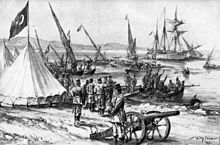Ayesha (ship)
|
SMS Ayesha
|
||||||||||||
|
||||||||||||
|
||||||||||||
|
||||||||||||
The Ayesha was a wooden topsail schooner with which a landing division of SMS Emden was able to escape captivity in November 1914 after their ship was destroyed in a battle with HMAS Sydney .
history
The Ayesha was an approx. 30 meter long, 7.5 meter wide three-masted topsail schooner of 97 GRT , which originally served to supply the British crew of the Cocos Islands and to transport copra to Batavia in the Dutch East Indies . The crew at that time consisted of a captain and five men. With the establishment of a steamboat connection , the ship was no longer used and was dismantled in the port of Port Refuge, Direction Island .
On November 9, 1914, the landing department of the small cruiser Emden of the German Imperial Navy was on the island to attack the cable and radio station there. At this time, her ship was brought up by the Australian light cruiser HMAS Sydney and shot to the wreck, the part of the crew remaining on the Emden was captured or died. To escape from the island, the detachment, under the command of Lieutenant Hellmuth von Mücke, took possession of the Ayesha . The crew now consisted of three officers , six non-commissioned officers and 38 men .

The English crew of the radio station supplied him with food, but were able to remove the seals from the sailor's sea valves unnoticed , so that the ship was constantly making water and the bilge pumps did not work properly. It should also be found that the confiscated sailor was badly rotten and leaky, and the four drinking water tanks could not be cleaned, so that three of them were rotting. Four machine guns with 2,000 rounds of ammunition each, 29 88 and 98 rifles with 60 rounds each and 24 pistols with ammunition were brought on board. Equipped in this way and under the imperial war flag , which had been rescued from the half-sunk Emden , the crew evaded the access of the crew of the Sydney . Despite these shortcomings, the Ayesha reached Padang on the west coast of Sumatra on November 27th , but had to leave the Dutch port within 24 hours due to the neutrality regulations, as she was now considered a ship of the Imperial Navy.

During the time in Padang, at a meeting on site, the German consul managed to slip a note from Mücke with the coordinates for a meeting point with a German merchant ship. On December 14th, the Ayesha met the steamer Choising of the North German Lloyd off Padang . The crew changed over to the steamer and the Ayesha was on December 16, 1914 at 16:58 to 1,709 nautical miles travel in position 3 ° 14 ' S , 100 ° 35' O sunk.
Movie
- In the film The Men of Emden , the Ayesha is portrayed by the schooner Raja Laut .
See also
literature
- Hellmuth von Mücke: Ayesha. Verlag August Scherl, Berlin 1915; archive.org
- Erich Gröner: The German warships 1815-1945. Volume VIII / 2. J. F. Lehmanns Verlag, Munich 1968, p. 541.
- Hans H. Hildebrand, Albert Röhr, Hans-Otto Steinmetz: The German warships. Mundus Verlag, Ratingen o. J.
- Schooner Ayesha . In: Ships-People-Fates , No. 97
- Olaf Fritsche: Desert sailors. Cecilie Dressler Verlag, Hamburg 2008
Web links
- Ayesha . deutsche-schutzgebiete.de
